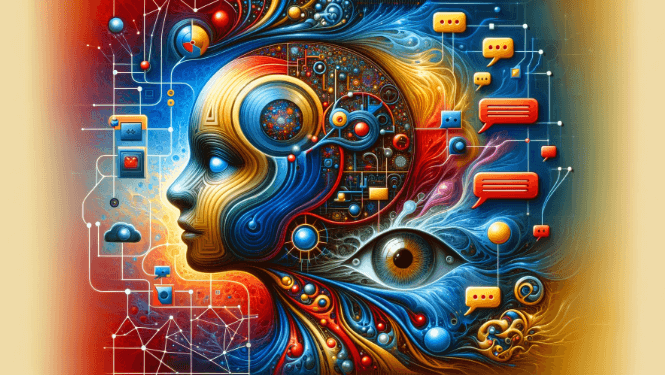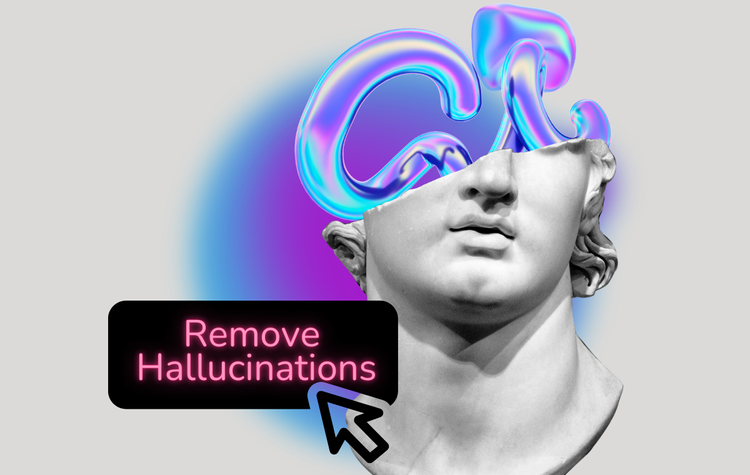Everything You Need to Know About Chatbot Hallucination
Generative AI chatbots are amazing, but they sometimes hallucinate or make things up. Gleen AI is an enterprise-ready generative AI chatbot that can be trained on a proprietary knowledge base. Most importantly, Gleen AI doesn't hallucinate.

Generative AI chatbots are amazing tools. However, they sometimes face an issue known as chatbot hallucination. This means they might give answers that are wrong or made-up.
Though it may seem like a small problem or even funny, it can actually lead to serious mistakes.
In this article, we're going to look closely at chatbot hallucination. We'll figure out what causes it and why it happens.
It's important to know why and when chatbots might give these strange answers. Understanding this helps us to solve and reduce these issues.
What are Chatbot Hallucinations?
Chatbot hallucination is an interesting issue in AI. It happens when AI chatbots, which are built to understand and respond to text, give answers that are wrong or don't make sense.
Why does this happen? Although chatbots are trained with lots of information, they sometimes get it wrong. They might give answers that seem strange or are not correct.
It's really useful to know why chatbots hallucinate. They might give these odd answers because they are trying to use their training in a way that isn't quite right. This could be because of missing information in their training or just because human language is complex.
Knowing when and why chatbots hallucinate is key. It helps us to make them better, ensuring they give more reliable and correct answers.
What is an Example of a Chatbot Hallucination?
A recent survey by Tidio discovered that 72% of people trust AI chatbots to give correct and reliable information.
Yet, interestingly, 75% of those surveyed also said that they've been misled by an AI chatbot at least once.
So, when AI chatbots hallucinate?
This leads us to examples of chatbot hallucinating. It's when chatbots, expected to provide accurate responses, end up giving incorrect or misleading information.
It's important to be aware of these occurrences to better understand how and when chatbots might not always be reliable.
Source Conflation
Sometimes, chatbots mix up their information. This is called source conflation. It happens when a chatbot pulls together bits of info from different places but gets the facts wrong.
Think of it like trying to make one big picture from puzzle pieces that don't fit together.
What's more, chatbots might sometimes make up their sources. They could mention facts or details that aren't true or don't come from places we can trust.
This is a big deal because it can lead to mixed-up or false information. It's especially important to know this when we depend on chatbots to give us answers that are right and reliable.
Factual Errors
Chatbots using models like GPT-3.5 and GPT-4 can sometimes mix up true and false information. This mix-up, called hallucinating chatbot, results in content that's not factually accurate.
These models learn from the vast array of internet content, which isn't always correct. So, it's smart to double-check the facts given by chatbots for accuracy.
Being careful with chatbot information is especially crucial when you need correct facts. Knowing that chatbots might not always tell fact from fiction helps in using them wisely and avoiding misinformation.
Nonsensical Information
Chatbots like those using GPT-3.5 and GPT-4 models are good at guessing the next word in a sentence. Usually, they give answers that make sense. But sometimes, they create sentences that are grammatically right but don't actually make sense. This is known as chatbot hallucination.
These chatbot responses might sound really sure of themselves, even if they're not based on real facts. Often, this kind of mix-up is harmless or even funny. But it can sometimes cause big misunderstandings.
For instance, Peter Relan from Got It AI said in a Datanami interview that ChatGPT gets things wrong about 20% of the time. This shows why we should be careful with what chatbots say, especially when facts are important.
It's really important to know when a chatbot might be giving out weird or wrong information. This helps us use AI more wisely and avoid getting the wrong idea from what it says.
Examples of Chatbot Hallucination
Here are instances when chatbots hallucinate could have serious consequences:
Attorneys Facing Sanctions for Using Non-Existent Cases Cited by AI
In a notable case reported by Forbes, two lawyers faced potential sanctions for referencing six cases that didn't actually exist.
One of the lawyers, named Steven Schwartz, admitted that these fabricated legal cases were sourced from ChatGPT, a chatbot AI.
This incident highlights a critical example of how reliance on AI-generated information without proper verification can lead to significant professional consequences.
Law Professor Wrongly Implicated by Chatbot Accusation
In a case reported by The Washington Post, a response from a chatbot, specifically ChatGPT, wrongly accused a law professor of sexual harassment.
The chatbot erroneously referenced a non-existent article from The Washington Post as its source of information, leading to a false accusation.
Misleading Court Case Summary
When asked about the Second Amendment Foundation v. Ferguson case, ChatGPT, a chatbot, gave wrong information. It incorrectly said that Alan Gottlieb, the SAF's founder, sued Georgia radio host Mark Walters. The chatbot also falsely claimed that Walters was involved in fraud and embezzlement within the foundation.
This mistake shows why it's crucial to understand that AI chatbots, even advanced ones like ChatGPT, can sometimes give misleading information. Users need to be careful and double-check facts, especially in serious matters like legal cases.
As a result of this inaccurate summary, Walters sued OpenAI LLC, claiming that the chatbot's response was completely false. This incident raises questions about how much we can trust AI chatbots to give correct summaries of complex issues like court cases.
Why Do Chatbots Hallucinate?
Chatbots hallucinate primarily due to the nature of the Large Language Models (LLMs) they are based on. Here’s a breakdown of why this happens:
Use of Large Language Models (LLMs)
Generative AI chatbots are built on Large Language Models like GPT-3 or GPT-4. These models are trained on vast amounts of text data from the internet.
Nature of Large Language Models
LLMs, by their design, are not infallible.
They are trained to predict the next word in a sequence based on the context provided by the input text.
This prediction is based on probabilities and patterns learned from their training data.
Hallucination in LLMs
Hallucination in this context refers to the model generating text that is either nonsensical or factually incorrect despite being grammatically coherent.
This happens because LLMs are trying to generate the most probable next word or sentence based on their training, which might not always align with factual accuracy.
In other words, LLMs hallucinate by design. They don’t have the ability to discern true information from false or to verify the authenticity of their sources.
Here's a brief video that describes what a why LLMs hallucinate:
Transference to Chatbots
Since generative AI chatbots use these LLMs, they inherit this tendency to hallucinate. When a chatbot is prompted with a query, it uses the LLM to generate a response.
If the LLM ‘hallucinates’ during this process, so does the chatbot.
Is Chatbot Hallucination a Bad Thing?
Chatbot hallucinations aren't always negative. Sometimes, they can enhance creativity. For example, they help chatbots create unique stories, characters, and scenes.
These hallucinations stem from the chatbot's diverse training data. They can be a source of fresh, imaginative ideas, offering a range of possibilities.
Chatbot hallucinations also promote diversity. They enable chatbots to present a variety of ideas and perspectives, enriching conversations.
However, in situations where precision is key, chatbot hallucinations can be problematic. They might spread incorrect information or unintentionally reinforce biases, affecting the reliability of these AI systems.
In fully automated services, like customer support, chatbot hallucinations might lead to misunderstandings or unsatisfactory interactions.
So, Chatbots sometimes make things up. Is AI hallucination problem fixable?
Reducing hallucinations in chatbots is a challenging problem. Here are some strategies:
Use Detailed Prompts: Provide your chatbot with precise, detailed prompts. This extra context helps anchor the chatbot in reality, making it less prone to hallucinate.
LLM Fine-Tuning: Tailor your underlying LLM with specific training data relevant to its domain. This fine-tuning makes the chatbot more adept at offering relevant and accurate responses.
Here's a brief video that provides an overview of LLM Fine-Tuning:
Retrieval-Augmented Generation (RAG): RAG involves giving the chatbot both the user's question and relevant context from a knowledge base. It helps the chatbot to generate responses that are more accurate and relevant.
Here's a brief video that describes how a RAG-based chatbot works:
Turn to Third Party Solutions for Hallucination: Address hallucination outside the chatbot's LLM. For instance, solutions like Gleen AI minimize hallucinations by carefully selecting what inputs the chatbot receives and identifying hallucinations in the chatbot's responses.
Here's a video of Gleen AI and a GPT trained on the same knowledge base. The GPT hallucinates, but Gleen AI doesn't.
Gleen AI – The Efficient, Commercial Solution for Chatbots
Customizing a chatbot often involves significant time and resources. Continuous training for fine-tuning can be costly and time-consuming.
Moreover, investing heavily in retrieval-augmented generation (RAG) and prompt engineering doesn't completely solve the hallucination issue.
However, Gleen AI offers a practical alternative for chatbots. As a readily available commercial product, it is designed to proactively mitigate hallucination.
80% of Gleen AI's technology is dedicated to preventing hallucinations. And unlike the extensive process of chatbot fine-tuning, Gleen AI can be implemented in just a few hours.
Request a demo of Gleen AI, or create your own free generative AI chatbot using Gleen AI now.



